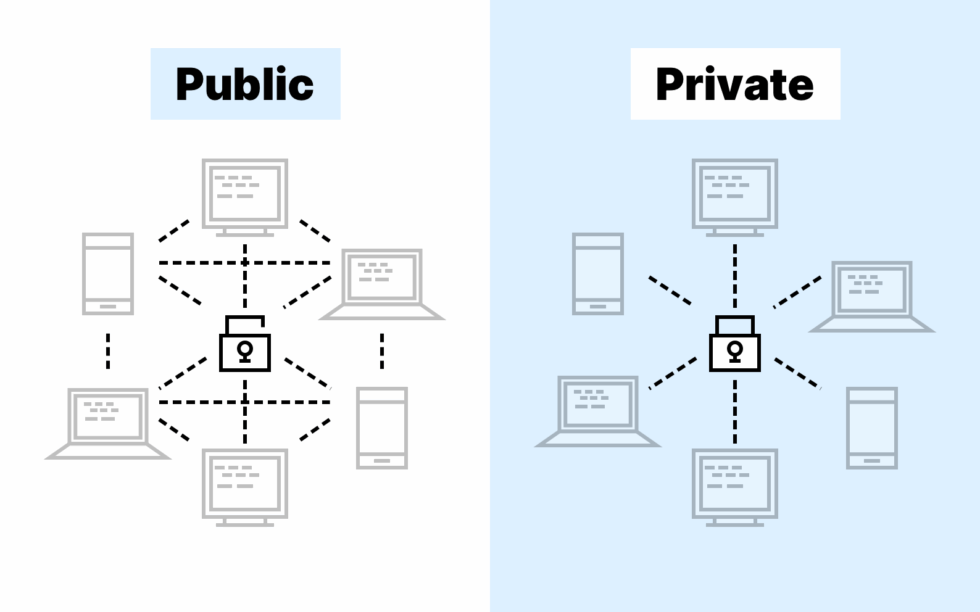
In the ever-evolving world of blockchain technology, not all chains are created equal.
While the average crypto enthusiast may think of Bitcoin or Ethereum when they hear “blockchain,” the underlying technology has branched far beyond public networks into the world of enterprise-grade blockchains — private, permissioned, and designed with a very different user in mind.
So, what’s the difference between a public blockchain and an enterprise (or private) blockchain? Why would a company choose one over the other? Let’s dive into the mechanics, benefits, trade-offs, and use cases of these two distinct but powerful strands of the blockchain universe.
Setting the Stage: What is a Blockchain, Really?
At its core, a blockchain is a distributed ledger — a database that’s replicated across multiple nodes and secured using cryptography and consensus mechanisms. Once data is written to the chain, it’s nearly impossible to alter retroactively, making it ideal for environments where trust, transparency, and immutability are critical.
But how that trust is established — and who gets to participate — varies drastically between public and enterprise blockchains.
Public Blockchains: Open, Decentralized, and Trustless
Public blockchains are the original vision of distributed ledgers: open, permissionless, and globally accessible.
✅ Key Characteristics:
- Permissionless: Anyone can join the network, read the data, submit transactions, and participate in consensus (e.g., mining or staking).
- Fully decentralized: No central authority. The network operates on a peer-to-peer basis.
- Transparent: All transactions are visible to everyone.
- Incentivized economy: Participants are rewarded with tokens (e.g., BTC, ETH) for maintaining and securing the network.
🌐 Examples:
- Bitcoin – Focused on peer-to-peer digital currency.
- Ethereum – A programmable blockchain with smart contracts.
- Solana, Cardano, Avalanche – High-performance networks offering alternatives to Ethereum.
🟢 Use Cases:
- Decentralized finance (DeFi)
- Non-fungible tokens (NFTs)
- Open-source applications
- Censorship-resistant communication
Why Public?
The ethos here is openness and resilience. Public blockchains thrive on decentralization — no single entity can control or shut them down. This makes them ideal for building trustless systems where users don’t need to rely on intermediaries.
Enterprise Blockchains: Controlled, Permissioned, and Purpose-Driven
Enterprise blockchains — also called private or permissioned blockchains — are designed with a different goal in mind: control, compliance, and scalability within organizations or closed consortia.
✅ Key Characteristics:
- Permissioned: Only approved participants can access the network and its data.
- Centrally governed: An organization or consortium often manages nodes, policies, and access rights.
- Private transactions: Data is shared only with relevant parties.
- Tailored infrastructure: Can be customized for throughput, latency, privacy, and integration needs.
🔧 Examples:
- Hyperledger Fabric – Modular architecture for private blockchain networks.
- R3 Corda – Built for financial institutions with legal contract support.
- Quorum – An enterprise-focused version of Ethereum developed by JPMorgan.
- Ripple – Enables real-time cross-border payments with banks and financial entities.
🏢 Use Cases:
- Supply chain management
- Trade finance and settlements
- Healthcare record sharing
- KYC and identity verification
- Interbank transactions
Why Enterprise?
For regulated industries like finance, healthcare, logistics, and government, full transparency isn’t always desirable. Instead, enterprise blockchains prioritize privacy, governance, and performance, ensuring compliance with legal and operational requirements.
Head-to-Head Comparison: Public vs. Enterprise Blockchain
| Feature | Public Blockchain | Enterprise Blockchain |
|---|---|---|
| Access | Open to anyone | Restricted to known participants |
| Governance | Decentralized, community-driven | Centralized or consortium-managed |
| Transparency | Full transaction visibility | Selective visibility (private channels) |
| Consensus | Proof-of-Work, Proof-of-Stake, etc. | Simplified consensus (e.g., RAFT, PBFT) |
| Performance | Slower (high decentralization) | Faster (fewer nodes, trusted environment) |
| Scalability | Limited by design | More scalable due to controlled environment |
| Use Case Fit | Open finance, Web3 apps | B2B applications, regulated industries |
Security & Trust Models: A Philosophical Divide
The security model of public blockchains relies on economic incentives and game theory. Miners and validators are kept honest because cheating is expensive and often unprofitable.
Enterprise blockchains, by contrast, assume trust between known parties. Security is enforced not through incentives, but through legal agreements, organizational control, and IT infrastructure.
This reflects a fundamental philosophical divide:
- Public chains eliminate trust by distributing it.
- Enterprise chains manage trust by controlling it.
Both are valid approaches — just for different contexts.
Tokenization: Not Always a Factor in Enterprise Blockchain
Public blockchains are token-centric ecosystems. Whether it’s ETH, SOL, or a DeFi governance token, the native token plays a role in securing the network and aligning incentives.
Enterprise blockchains, on the other hand, often do not rely on native tokens. Their goal isn’t to build an economic layer, but rather to enable data integrity, auditability, and interoperability within and between businesses.
However, tokenization is entering the enterprise world in new forms — particularly with the rise of real-world asset (RWA) tokenization, where enterprises create blockchain-based representations of commodities, real estate, or financial instruments.
Interoperability and Hybrid Models: Best of Both Worlds?
Many forward-thinking organizations are now experimenting with hybrid blockchain models, leveraging both public and private chains.
For example:
- Sensitive customer data might be stored on a private blockchain.
- Transaction proofs or hashes could be anchored on a public chain (like Ethereum) to ensure immutability and transparency.
Frameworks like Polkadot, Cosmos, and Polygon’s Supernets are also enabling cross-chain communication, allowing enterprise blockchains to talk to public chains without compromising privacy or scalability.
Real-World Examples in Action
- IBM & Maersk (TradeLens): Used Hyperledger Fabric to digitize global shipping logistics, involving ports, carriers, and customs.
- JPMorgan’s Onyx: Built a private version of Ethereum (Quorum) for interbank transactions and tokenized deposits.
- CVS Health: Leveraged blockchain to manage COVID-19 vaccine credentials securely.
These examples showcase the power of enterprise blockchains when tailored to specific industry needs, with privacy, control, and compliance as top priorities.
Final Thoughts: Choosing the Right Tool for the Job
The debate between enterprise and public blockchains isn’t about which is superior — it’s about context.
- Building a decentralized DeFi app or NFT marketplace? You’ll need a public chain.
- Managing a cross-border trade finance network between banks? An enterprise blockchain makes more sense.
As blockchain adoption accelerates across both public and private sectors, understanding these distinctions is key. What’s clear is this: blockchain is no longer just for crypto enthusiasts. It’s for businesses, governments, and global systems.
In the digital economy of tomorrow, both public and enterprise blockchains will play pivotal roles — often working together in ways we’re only beginning to imagine.





